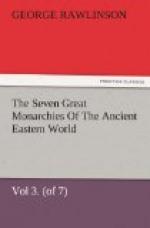Of the first period it cannot be said that we possess any distinct historical knowledge. The Median dynasty of Berosus at Babylon appears, by recent discoveries, to have represented those Susianian monarchs who bore sway there from B.C. 2286 to 2052. The early Median preponderance in Western Asia, if it is a fact, must have been anterior to this, and is an event which has only left traces in ethnological names and in mythological speculations.
Our historical knowledge of the Medes as a nation commences in the latter half of the ninth century before our era. Shalmaneser II.—probably the “Shalman” of Hosea,—who reigned from B.C. 859 to B.C. 824—relates that in his twenty-fourth year (B.C. 885), after having reduced to subjection the Zimri, who held the Zagros mountain range immediately to the east of Assyria, and received tribute from the Persians, he led an expedition into Media and Arazias, where he took and destroyed a number of the towns, slaying the men, and carrying off the spoil. He does not mention any pitched battle; and indeed it would seem that he met with no serious resistance. The Medes whom he attacks are evidently a weak and insignificant people, whom he holds in small esteem, and regards as only deserving of a hurried mention. They seem to occupy the tract now known as Ardelan—a varied region containing several lofty ridges, with broad plains lying between them.
It is remarkable that the time of this first contact of Media with Assyria—a contact taking place when Assyria was in her prime, and Media was only just emerging from a long period of weakness and obscurity—is almost exactly that which Ctesias selects as a day of the great revolution whereby the Empire of the East passed from the hands of the Shemites into those of the Arians. The long residence of Otesias among the Persians, gave him a bias toward that people, which even extended to their close kin, the Medes. Bent on glorifying these two Arian races, he determined to throw back the commencement of their empire to a period long anterior to the true date; and, feeling specially anxious to cover up their early humiliation, he assigned their most glorious




